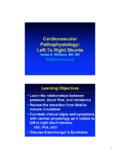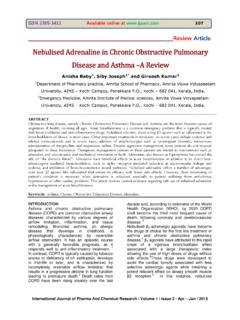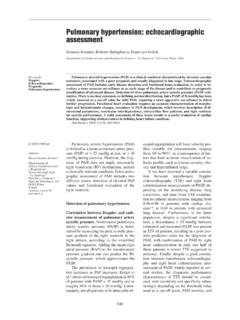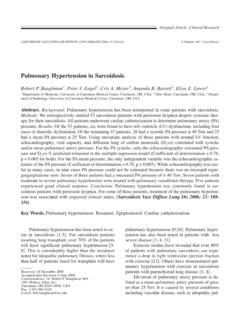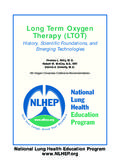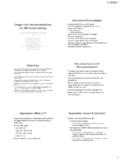Transcription of 160 Respiratory physiology - part 2 - FRCA
1 Sign up to receive ATOTW weekly - email ATOTW 160. Respiratory physiology , 16/11/2009 Page 1 of 12 Respiratory physiology part 2 ANAESTHESIA TUTORIAL OF THE WEEK 160 16th November 2009 Dr Nadine Dobby Anaesthetic Registrar Dr Sarah Chieveley-Williams Consultant Anaesthetist University College London Hospital Correspondance to or QUESTIONS Before continuing, try to answer the following questions. The answers can be found at the end of the article, together with an explanation. 1. The oxyhaemoglobin dissociation curve is shifted to the left by: a) an increase in arterial PCO2 b) acidosis c) a decrease in 2,3 DPG d) carbon monoxide e) a fall in temperature 2.
2 Anatomy of the Respiratory tract a) the alveoli humidify gas b) generations 1- 18 are known as the conducting zone of the lungs c) there are 25 bronchial generations d) bifurication of the bronchi occurs at T4 e) the lungs are lined with transistional epithelium 3. Dead space a) is defined as the volume of gas which does take part in gas exchange b) physiological dead space is the same as alveolar dead space c) anatomical dead space is measured by the Bohr equation d) dead space is usually about 45% of tidal volume e) occurs with pneumonia 4. pulmonary vascular resistance a) is high at high lung volumes b) is low at low lung volumes c) can cause heart failure d) is calculated using PCWP e) is decreased by nitrous oxide 5.
3 Diffusion of gases a) is increased with a decrease in surface area b) is indirectly proportional to the concentration gradient c) is not governed by Grahams law d) is directly proportional to the thickness e) is decreased according to Beers law Sign up to receive ATOTW weekly - email ATOTW 160. Respiratory physiology , 16/11/2009 Page 2 of 12 6. Gas transport in the blood a) there is about 15ml of oxygen per 100ml of oxygenated blood b) oxygen CO2 is mainly tranported as carbamino compounds c) CO2 is carried best by oxygenated haemoglobin d) More oxygen is carried dissolved in blood than CO2 e) CO2 is transported in the blood by 3 main routes PERFUSION OF THE LUNG Blood flow to and around the lung is similar to any other organ but at much lower pressures than the systemic system (see diagram).
4 The blood vessels in the lungs continually branch and get consistently smaller very like the branching of the airways. The pulmonary arteries whose walls are very thin in comparison to that of the arteries in the main circulation feed the lung up to the level of the terminal bronchioles and then split into the capillary bed. The capillaries have great capability to distend thus enhancing gas exchange and reservoir action. Once the red blood cells have become oxygenated the capillary bed is drained into venules which then join to form the pulmonary veins. It is the ability of the blood vessels to distend and be recruited which allows the pressures in the pulmonary system to stay low despite very high blood flow.
5 The pulmonary arteries only supply blood flow and oxygen to the lungs and must have the ability to accept huge blood volumes at times. The low pulmonary pressures are important to minimise the work of the right heart. Figure 6: The pressures within the main and pulmonary circulatory systems Sign up to receive ATOTW weekly - email ATOTW 160. Respiratory physiology , 16/11/2009 Page 3 of 12 pulmonary vascular resistance PVR = 80 x (MPAP - PCWP ) / CO Acute and chronic lung disease Both can cause an increase in PVR. Chronic PVR can lead to right sided heart failure Lung volumes PVR depend on the alveolar and extra-alveolar resistances. Both low and high lung volumes will increase PVR, it is at its lowest at FRC.
6 Alveolar vessels or pulmonary capillaries will become overly stretched longitudinally at high lung volumes and therefore their resistance will increase. With extra alveolar vessels resistance will increase at low lung volumes since they are not encouraged to expand by lung parenchyma. PVR can also be altered through the distension and recruitment of pulmonary vessels which have a large ability to increase their capacitance. Hypoxic pulmonary vasoconstriction In response to episodes of low partial pressure of alveolar oxygen the lung will divert its own blood supply to areas of properly ventilated lung tissue. This is important in matching and maintaining ventilation to perfusion in the lung.
7 HPV is also obtunded by the general anaesthetic inhalational agents, it is relatively preserved by TIVA. Metabolic substances Endothelin released from the lung endothelial cells in response to tissue damage is a very potent vasoconstrictor Prostacyclin a naturally occurring vasodilator Nitric oxide Also known as endothelin derived relaxing factor a potent vasodilator Perfusion throughout the lungs Taking all of the above into account it is easy to understand then why blood flow is not always even throughout the lung. Gravity plays a large part in directing blood flow by setting up a hydrostatic pressure gradient which is higher at the base of the lung than at the top.
8 Blood is preferentially directed to the lung bases. As well as the affect of gravity on perfusion and ventilation, the differing pressures within the alveoli, arteries and venous systems heavily influences the outcome. The relationship between these factors describes West zones. West zones within the lung are 3 vertically split zones (in the upright subject) which explain how alveoli, arterial and venous pressures differ in each zone and thus affect perfusion and ventilation throughout the lung. In zone 1 the alveolar pressure may exceed that of the arterial and venous pressure and thus little perfusion will occur as the vessels collapse, this then leads to dead space.
9 In zone 2 the arterial pressure will exceed that of the alveoli pressure but not the venous pressure. In zone 3 both the arterial and venous pressures exceed the alveoli pressure. Sign up to receive ATOTW weekly - email ATOTW 160. Respiratory physiology , 16/11/2009 Page 4 of 12 Figure 7: West Zones GAS EXCHANGE The partial pressure of oxygen that is inhaled from our natural environment through normal inhalation is not maintained at the same partial pressure by the time it reaches the alveoli and indeed the mitochondria. The process by which this decrease in partial pressure occurs is called the oxygen cascade. The air surrounding us how much oxygen does it contain?
10 Dry atmospheric air gas 21% of 100 KPa Therefore 21 KPa or 160mmmg However as gas is inspired it is diluted by water vapour which reduces the partial pressure of oxygen Water vapour KPa/ 47mmHg PO2 = x (760-47)= 149mmHg PO2 = x ( ) = Key points The lung is a low pressure system Low pulmonary pressure minimises the work of the right heart The pulmonary vessels distend and recruit to maintain low pressures Very high and very low lung volumes increase pulmonary vascular resistance Hypoxic pulmonary vasoconstriction diverts blood flow away from poorly ventilated regions of lung HPV is obtunded by anaesthesia Clinical points Ventilatory stategies can prevent increases in pulmonary pressures low tidal volumes, permissive hypercapnia TIVA does not affect HPV Sign up to receive ATOTW weekly - email ATOTW 160.










